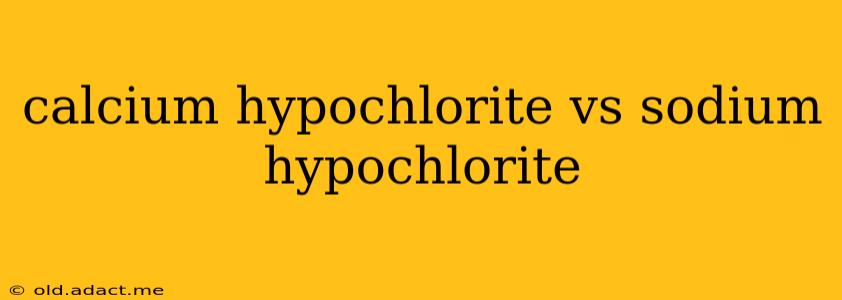Choosing the right pool disinfectant is crucial for maintaining a clean, safe, and enjoyable swimming environment. While both calcium hypochlorite and sodium hypochlorite are powerful chlorine-based sanitizers, they possess distinct characteristics that make them suitable for different needs and applications. This comprehensive guide delves into the key differences between these two common pool chemicals, helping you make an informed decision for your specific situation.
What is Calcium Hypochlorite?
Calcium hypochlorite, often known as "cal hypo" or "high-test hypochlorite," is a solid granular or tablet form of chlorine. It contains a higher concentration of chlorine (typically 65-73%) compared to sodium hypochlorite, making it a more potent sanitizer and algaecide. This high concentration translates to a smaller volume needed for the same level of disinfection.
Advantages of Calcium Hypochlorite:
- Higher Chlorine Concentration: Less product is needed for effective sanitation, resulting in potentially lower overall costs.
- Longer Shelf Life: Its solid form contributes to a longer shelf life compared to liquid sodium hypochlorite.
- Effective Algaecide: Its strong chlorine content helps prevent and control algae growth effectively.
Disadvantages of Calcium Hypochlorite:
- Can Increase Calcium Hardness: Regular use raises the calcium hardness of your pool water, potentially leading to scale buildup on surfaces and equipment. This requires more frequent monitoring and potentially the use of calcium hardness reducers.
- More Corrosive: It's more corrosive than sodium hypochlorite, potentially damaging pool equipment if not handled carefully.
- Dust and Handling: Handling the granular or powdered form can be messy and cause respiratory irritation if inhaled.
What is Sodium Hypochlorite?
Sodium hypochlorite, commonly known as bleach, is a liquid form of chlorine typically found in a 10-15% concentration. It's readily available and easily dissolved in water, making it a convenient option for many pool owners.
Advantages of Sodium Hypochlorite:
- Easy to Use and Dissolve: Its liquid form simplifies the addition and dissolution process compared to solid calcium hypochlorite.
- Lower Calcium Hardness Increase: It contributes less to increased calcium hardness than calcium hypochlorite.
- Less Corrosive: It's less corrosive than calcium hypochlorite, minimizing the risk of damage to pool equipment.
Disadvantages of Sodium Hypochlorite:
- Lower Chlorine Concentration: You need a larger volume for effective sanitation compared to calcium hypochlorite.
- Shorter Shelf Life: Its liquid nature and susceptibility to degradation result in a shorter shelf life.
- Can Be Less Effective Against Algae: While effective for sanitization, it may require supplemental algaecides for effective algae control.
Calcium Hypochlorite vs. Sodium Hypochlorite: Which is Right for Me?
The best choice depends on your individual needs and priorities. Consider these factors:
- Pool Size and Frequency of Use: For larger pools or those frequently used, calcium hypochlorite's higher concentration may be more economical. Smaller pools might find sodium hypochlorite easier to manage.
- Calcium Hardness Levels: If your pool already has high calcium hardness, sodium hypochlorite is the safer choice.
- Budget: While calcium hypochlorite may offer lower costs per treatment, you need to factor in the potential costs of managing increased calcium hardness.
- Ease of Use: Sodium hypochlorite is generally easier to handle and dissolve.
What are the safety precautions when using both?
Both calcium hypochlorite and sodium hypochlorite are powerful chemicals and require careful handling:
- Always wear protective gear: This includes gloves, eye protection, and a respirator when handling calcium hypochlorite.
- Never mix with other chemicals: Mixing these with acids or other cleaning products can create dangerous reactions.
- Store in a cool, dry place: Keep them away from heat sources and direct sunlight.
- Follow manufacturer's instructions carefully: Always adhere to the recommended dosage and application methods.
Which is better for shocking a pool?
Both can be used for shocking a pool, but calcium hypochlorite is often preferred due to its higher chlorine concentration. This allows for a more effective and rapid increase in free chlorine levels. However, remember to follow the specific instructions on your chosen product.
What are the environmental impacts of each?
Both contribute to chlorine levels in the environment; however, the environmental impact also depends on proper handling and disposal. Always follow local regulations for the disposal of pool chemicals.
Ultimately, the decision between calcium hypochlorite and sodium hypochlorite hinges on your specific pool's needs, your budget, and your comfort level with handling different chemical forms. Carefully weighing the advantages and disadvantages of each will enable you to make the best choice for your swimming pool.
